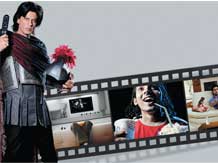JitendraKumar
Contributor
- Joined
- 30 Sep 2012
- Messages
- 7,108
- Reaction score
- 4,077

Dish TV, the first DTH player to enter India, has seen growth with another pre-emptive move. It was last year that it launched its regional DTH (direct-to-home) brand, Zing. DTH, a key segment in digital TV delivery platforms, mostly has players with a single brand, as the priority remains achieving profitability. Dish has been the first to market a second brand.
Salil Kapoor, COO, Dish TV, says that since Zing's launch in March, 2014, the brand has grown in triple digits.
Profitability for Dish TV seems to be within reach as it brought down quarterly losses to Rs 2.9 crore in the third quarter (Q3) of FY-15 from Rs 38 crore in Q3 of FY-14.
DISH STATS IN Q3, FY-15
416,000 net subscriber additions; total net subscriber base at 12.5 million
Overall ARPU at Rs 177 and HD ARPU at Rs 434
Subscription revenues of Rs 655 crore, up 17.4% year on year
Share of HD boxes in revenue is 17%
Net loss Rs 2.9 crore, down from Rs 38 crore in Q3, FY-14
While Dish's strong quarter can be attributed to a host of reasons (see box), its regional strategy, will stand it in good stead in the future.
Dish TV's logic for a second brand was the need for a customised entity for users who would enter the digital fold in the third and fourth phase of digitisation (tier II, III towns and rural areas), as local cable operators, in these mass-media-heavy areas, would get active in soliciting subscriptions.
"Also, the pushing back of the deadline of the third and fourth phases has been good for DTH players, especially, for us as it gives us more time to build both the brands. However, we had a plan independent of the deadline as we knew that we had to lay the foundation in advance. The current Dish TV rates and packaging would not have appealed to the smaller-town audience. Zing was conceptualised to give packages customised for that audience at price-points that work for it. Even in, say, a metro like Kolkata, the demographics of a Dish TV consumer and a Zing consumer will be different," says Kapoor.
Dish reworked the physical packaging in vernacular languages. The base pack of Zing, was priced between Rs 99 a month in Telangana and Rs 179 a month in Maharashtra, compared to Dish TV's range of base packs from Rs 230 to Rs 499 a month. As for the content, Zing's base pack focuses on the region's prevalent language channels (a mix of paid and free-to-air) and other national channels are offered as add-ons.
Dish TV expects to be profitable in the next two-three quarters, with an eye on increasing top line while curtailing costs. The three factors that have helped are:Taking a tough stand on content costs when deals came up for renewal, such as the one with Indiacast (distributor of Viacom18)
Aggressively putting its own, trained sales staff on ground, rather than relying only on vendors or agencies to reach customers
Differentiating between Dish TV and Zing. The former pegged on HD and sports content and the latter on regional packaging and pricing
Other DTH brands, including Dish TV, focus on national general entertainment channels (GECs), news, sports and niche channels that are mostly in Hindi and English.
After its launch in West Bengal, Zing was taken to other markets such as Odisha and Tripura and now covers seven states: Maharashtra, Tripura, Odisha, West Bengal, Andhra Pradesh, Tamil Nadu and Telangana. Kapoor says that in states such as Odisha, the total share has doubled from what Dish TV alone managed, after Zing's entry. On a national level, Dish TV and Zing together have around 26 per cent, followed by Tata Sky at 20 per cent and Videocon d2h at 18-19 per cent.
While Zing will be expanded to more states, Dish TV will hold its focus on sports and high definition (HD) content. In August last year, it overhauled its content with an eye on merging the year-round sports calendar with the emergent new leagues (domestic and international) spanning non-cricket sports like football, tennis, hockey and kabaddi. Three of the four Dish TV packages include all the 11 sports channels available and the tactic has played a role in expanding its subscriber base.
Boosting up the high-average revenue per user (Arpu) segment of HD boxes and services, too, is on Dish's list. "We have seen very good incremental sales in our HD boxes," says Kapoor. The next two players in the DTH rankings, Tata Sky and Videcon d2h, have, meanwhile, introduced ultra-HD (UHD) products (boxes and channels). These players want to capitalise on the packed sports calendar ahead to let these high-end products take off; UHD tends to super-clarify sports-viewing.
Tata Sky has priced its boxes at Rs 5,900 for existing customers and Rs 6,400 for new ones. Videocon d2h, which raised Rs 1,900 crore earlier this month, will be launching its boxes soon. Dish TV, however, would like to wait for critical mass before entering the space, says Kapoor.
Business Standard

 wall:wall
wall:wall